The Big Score: An Analysis of Pikmin 2
By gamer_152 5 Comments
Note: The following article contains major spoilers for Pikmin and Pikmin 2.

There are a few details which remain inconsistent between the first three Pikmins yet are vital for the character of each:
- The number of protagonists.
- The items you collect.
- The pikmin you use to collect them.
We're going to deconstruct how Pikmin 2 handles these areas of the ludonarrative. But before we can start talking about sumo wrestler plant men and picking biscuits out of the dirt, we should ask, what's even going on in Pikmin 2?
Return to the Planet of the Pikmin
Pikmin 2's story starts hot on the heels of the original. While Captain Olimar was absent from his job at Hocotate Freight, his employer became mired in debt, and its president sold off his beloved S.S. Dolphin to pay the piper. But Olimar and The President inadvertently discover that a bottlecap from Earth is worth mucho "pokos", the local currency. They hatch a plan for our weary protagonist to return to the Planet of the Pikmin with a copilot, Louie. There, Olimar and Louie will try to scrape together 10,000 pokos' worth of "treasure" and put Hocotate Freight back in the black. You have to feel for the captain here. As soon as he lands home, he's being shipped back to the remote world he came from.
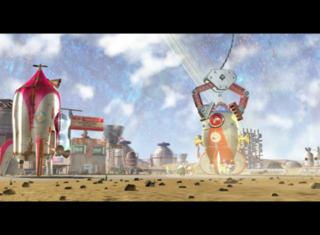
You may already know about Nintendo's nod to the Super Mario games in here: Olimar, the short, stout protagonist, has a name that contains all the letters in "Mario", while Louie, the taller, skinnier one, has the first two syllables of "Luigi" for a name. Olimar describes Louie as quiet and enigmatic, with a keen interest in insects. The two are joined by a newer, shabbier, talking Hocotate Rocket that gives its two pokos on fresh mechanics and other topics, while journal entries and emails peel back the layers of The President, the astronauts, and their families.
We can switch between Olimar and Louie at any time by pressing the Y button, with each of them having the full suite of powers to shepherd the pikmin. This means that you can now split the party to get more jobs done at once, and have one foreman oversee one crew while another does the same or performs more active work with a second group. Character switching allows for a denser volume of activity throughout the in-game day and less time marching around the map wrangling workers, as you now have two pairs of feet to cover a level. This is especially useful at the end of days when any pikmin not in your party or near the onions are eaten alive. Instead of the sun setting on you doing your rounds to return your troops to shelter, you can spend the final hours productive.
This improved capacity for multitasking is counterbalanced by the mental tax of dividing the workforce between the two protagonists. If you send Olimar to one side of a region with a bunch of red pikmin and Louie to the other side with a bunch of blue pikmin, and then find out Louie needs some red Pikmin, it's going to take a long time to make the hand-off. Forethought is everything as we need to harmonise the characters' actions with each other. That mechanical cooperation, along with the increased linguistic communication between Hocotations in this sequel, reflects the nature of your trip. It isn't a freak stranding as in the first game, but a coordinated mission. We could summarise Pikmin 2 as a co-op game where you control both avatars.
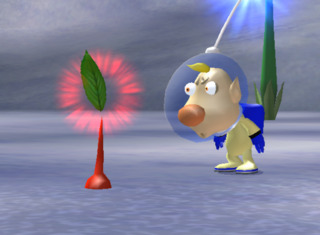
In addition to being a second pair of hands, Louie is extra company on the planet, even when he isn't on screen, because you always have to think about what the second commander is doing. He guards against the gnawing loneliness of this home away from home. If only there was actually a need to forage and defend yourself efficiently in the overworld.
The Longview
Pikmin 2 abolishes the original game's 30-day time limit, sanctioning you to plunder the planet to your heart's content. The upside is reduced stress, increased freedom, and the knowledge that you won't plug eight hours into the game only to reach the bad ending. As time is now an infinite resource, the levels also can't mislead you into wasting it collecting non-essential parts.
But if resources are infinite, how can we prove our resourcefulness? You could only finish Pikmin 1 inside 30 days with plenty of planning, decent hand-eye coordination, and a sixth sense for timing, especially if you wanted the bragging rights of 100%ing it. To complete Pikmin was to receive a certification of your organisational and manual skills. But when you can beat Pikmin 2 by wasting daylight and squandering your supplies, finishing it is no proof of exceptional aptitude. It's Resident Evil 7 without the Baker Family or Anno but with unlimited money. If Pikmin 2 introduced an equivalent macro-scale barrier to replace the time limit, that would be one thing, but it does away with such restrictions altogether.
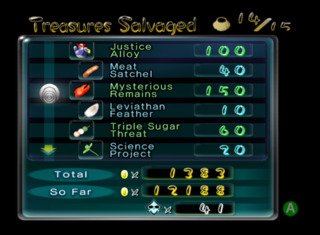
The scrapping of the clock also means that you can never experience the euphoria of being ahead or behind schedule because schedules imply deadlines. In the original entry, if I retrieve 18/30 parts in 14/30 days, I'm being expedient. If I only land 10 parts in 14 days, I'm dragging my feet. But if I have 7,000/10,000 pokos and there are infinite days left, that doesn't say anything about me as a player. Still, there's nothing wrong with having a points threshold as a long-term goal. It reminds me of some of the earliest adventure games. And that number of 10,000 is not a coincidence.
Using a power of ten as the target score allows us to calculate our progress through the game with no sweat. If we were aiming for 7,209 points and had 5,961, who knows what percentage we would be towards the credits. If we have 4,290/10,000 pokos, you don't need a calculator to know we are 42.9% of the way to the finish line. As you would expect for a sequel where the jackpot is 10,000 coins, this game's collection rate is a far cry from its big brother's. Under Pikmin 1's progress curve, you'd collect 0-2 shards of your rocket a day; you were one person dragging jewels and detectors back to camp to glue them together. Pikmin 2 is a frantic gold rush, a mission to locate and grab any treasure not nailed down, and that means a higher influx of valuables.
An increase in the sheer volume of collectables is possible because the juicy goal meat is sliced thinner this time. We're not collecting 30 things; we're collecting 10,000. With a faster throughput of items and a lot of granularity in the scoring, Pikmin 2 can also vary the worth of each collectable without short-shafting you. In the original, collecting an item that turns out to be trivial to the mission gives you a sinking feeling because each expedition takes a large chunk of the clock. In Pikmin 2, if it turns out some tat is only worth 30 pokos, it's fine. There's no time to waste and another trinket will be brought back to the Rocket soon enough, probably one valued higher than the last. We get that compulsive slot machine effect as there's the chance the next reward could always be worth a lot or a little.
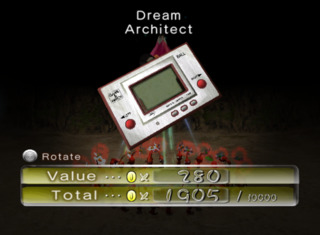
You'll notice that in the interim between the first and second game, Pikmin has moved its interest from the items that could be found on Hocotate to those that exist on Earth. The inaugural entry wants us to encounter the biology of our world as foreign, and 2 shares that impulse, while also forcing us to discover the possessions on Earth as if they were alien. Our trash is literally another person's treasure, and there is a whimsical novelty in seeing our guests put names and descriptions to objects they have no context for. A cookie becomes a "Succulent Mattress", and a cat bobblehead is dubbed the "Wiggle Noggin". But it wouldn't be Pikmin if it wasn't bittersweet, and all this human treasure without the humans makes you wonder, where did the people go?
Caves
Like all gold, Pikmin 2's is found in the ground. See, it's not that there's no resistance from this system. It's just that you won't find it on the surface, and it's less top-down. The challenge has burrowed into the Earth, seeped into the soil, and settled there as the game's caves. Jump into one of the rocky holes on the terra firma, and Olimar, Louie, and their current party will plunge into a multi-level dungeon.
In these instances, you do not have access to your full military, only the 100 (or less) pikmin you entered with. If you lose any humanoids in your descent to the bottom floor, you don't have the onions to grow more and will have to do without until you beat the area. That can be a sharp thorn in your side when there are plenty of obstacles you need specific colours of pikmin to neutralise, and you're splitting the crew you take into the cave between five different colours. If, for example, you find yourself in a maze of electrodes with no yellow pikmin at your back, you're going to have to step very gingerly.
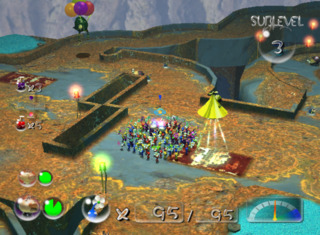
In the above world, we lack a measuring stick for our success, but in these trenches, it's returned to us. It comes in the form of the number of remaining Pikmin in our party. Although, that stick burns up at the exit to the dungeon and we have no quantitative target to compare that number against. It's not set in stone that you need to have forty or thirty pikmin by the end of an instance, for example. The spelunking missions capture the uncertainty of diving into a deep, dark hollow because we never know what we will encounter on the next floor or even how many floors there are. But in many of the tunnels, Pikmin 2 crosses over the line from being frictive to being anti-player. You may exit a cave at any time, but if you do that without finding a "geyser", which only exist at the end of caves, or at deep checkpoints in them, you lose all the treasure you've collected.
To say the underground is punishing would be to imply that when bad things happen to you, it's because of something you did wrong, and that can be true, but these stages consider tearing a line through your pikmin as a matter of course. In the final battle of Pikmin 1, Emperor Bulblax can eradicate the better part of your squad in a single lick, but in Pikmin 2, even mid-game enemies in the caves can do the same. Gatling gronks are impervious to strikes from the front and shoot missiles from well off-screen, while decorated cannon larvae spit homing boulders. Some floors pit you against creatures that you must rapidly throw Pikmin onto, but those predators dwell on narrow concourses and may flit about furtively, making it easy to throw Pikmin off the level. The game has spawned me in front of a Bulborb that can gobble down prey at lightning speed and on top of a beetle that can fart out clouds of poison.
The caves also get fixated on pulling pranks on you using their very own whoopie cushions: the bomb rocks. This dynamite has a fuse of a few seconds. I first encountered these explosives when Pikmin 2 dropped them from the ceiling without warning or any signal this could happen. I only had a few seconds to skedaddle and keep my pikmin from being turned to confetti. Then, the game dropped an egg full of nectar from above that initially registered to me as a bomb: a scary bit of misdirection. Next, it dispensed one of these eggs, but when I rallied my soldiers to drink its contents and power up, a bomb rock fell onto them. The game will give you enough time to forget about these grenades, then deploy one again, or rig one above a piece of treasure. It means you can unknowingly walk your workers into the path of danger and get them trapped behind valuables to be blown to smithereens.
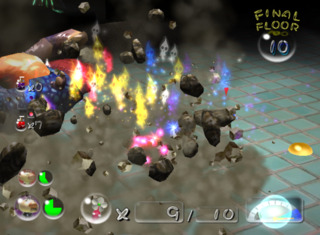
I've checked suspect alcoves of caves with Olimar and had no trap sprung on me, but when I sent pikmin in, one triggered without any trouble. There was a floor of one cavern where a rock dropped down, and I avoided it, then it grew legs and skittered towards my minions. I grabbed them and ran, discovering that the whole level was a nest of exploding spider paratroopers. On some floors, I resorted to ditching the pikmin altogether and wailing on enemies with Olimar or Louie's antennae. Does this take forever? Yes. Do the gameplay loops of Pikmin still captivate without the pikmin? No. But if you're attacking with the astronauts, you're not risking their underlings, and unlike the pikmin, Olimar and Louie can be steered away from a monster or bomb rock at the first sign of trouble. I have vivid memories of tumbling down floor after floor of these caves, praying that the next one would be the last. I'm basically like one of those guys who died in army.
It's not above these bunkers to throw you a bone. It can come in the form of nectar, which powers up pikmin, or "candypop buds", which allow you to change the colour of a few of your helpers. If heaven smiles on you, you might find the rare candypop that clones pikmin. These bonuses, as well as buried treasure, are often sequestered in recesses in the rock, sometimes behind a gate you must bust down. The destructible walls prevent you from carting out a fortune under the wildlife's noses. You must have your pikmin stand in place, drilling away at the stone for a while, which you can only do if they won't be subject to assault during their work routine. Although, in the game's final crevice, the Dream Den, these nooks mostly contain nothing. Their reason for existence is to disappoint you.
The final boss, the Titan Dweevil, slumbers on the fourteenth floor of the Dream Den, and weaponises fire, electricity, water, and poison. You must pummel each of its guns with pikmin to detach them from its body and open it up to damage. However, this bug's height and our distant, angled camera mean that it's tough to position yourself so you can latch pikmin onto its thorax. That is, unless you have plenty of the high-flying yellow variant, but you can't know that you need yellows before you've put in all the muscle it takes to get to the fourteenth floor. Additionally, none of the Dweevil's guns have a health bar, and by this point, you probably only have a handful of soldiers, so it's a long grind without a lot of positive feedback. It's not the note anyone would want their game to go out on.
Reset
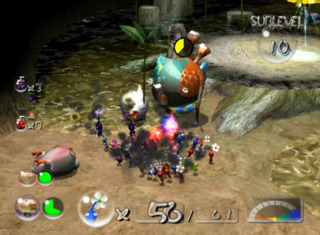
Gameplay in a Nintendo game doesn't get much spicier than this, and it's an outlier for a studio that had softened from their "Nintendo hard" front in the 80s to welcoming casual and family audiences through the 00s. Pikmin again becomes a laboratory for the company to experiment in without soiling the friendly reputation of their best-selling series. Realistically, I don't think the majority of Pikmin 2 players were going to see the game out without liberal use of the reset button. Less often because they "lost" and more often because if you're leading too few pikmin in a dungeon, your odds of completing it are slim.
The 2001 Pikmin approved of you loading your save to redo subpar runs. With the 2004 Pikmin, the etiquette is more ambiguous. In a dungeon, no menu offers you the option to return to the start of a day. If you want to backtrack, you have to give in to the temptation of the "Reset" switch on the GameCube's bonnet. It feels criminal. We can all see that the option to reload the floor doesn't exist because of a developer decision but because of a feature of the electronics that the studio has no control over. That feeling of deviance in hitting the button is magnified because of the ceremony of getting up and pressing it, and because resetting rerolls which level layout you get.
Then again, if the game's not playing fair, and you give yourself an advantage, isn't that evening the odds instead of cheating them? Some level designs are more beatable than others, so you can "fix" the difficulty by rerolling them. And couldn't we see the legitimate features of a game as developed not just by studios but also hardware manufacturers? Even if they weren't, I don't see how you would prove that the most authentic or "correct" version of a game is the one that the designer made for you and not one that you have added house rules to.
Purple and White
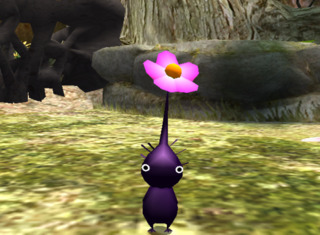
The tunnels aren't all flatulent bugs and aerial bombardments. They're also the only places you can grow the two new pikmin colours: purple and white. A staple of the Pikmin games is having your couriers ferry goods back to your rocket or onions. There is a minimum number of pikmin required to lift each object, and the more carriers you have for a body, the faster you can shift it. The stocky purple subspecies are slower than any other, but on the carry count, one purple pikmin qualifies as ten regular pikmin. Purple pikmin also stun monsters for the itty bittiest amount of time if you can land one directly on top of them. A deft player can kill a relatively robust animal by throwing a chain of purple pikmin onto its back so it doesn't have time to react before its health is depleted. The svelter white pikmin are resistant to poison and hurt predators that eat them. They are nature's silica gel packet.
The designs of these two new colours are refreshing. The most memorable features of the original pikmin are their invulnerabilities to elements: fire, electricity, or water. If the designers were plucking the low-hanging fruit, they'd just make the new pikmin resistant to new hazards: a teal pikmin that resists the cold, a grey pikmin immune to gift card scams, etc. Not content to phone in the play, Nintendo thinks about systems that all colours of pikmin have interacted with identically and sketches new pikmin that can interface with them differently. In the original title, there was a set amount of lifting power and speed that every pikmin had, and one getting eaten was always a loss. No more.
Flipping the mechanics over, consider that if each pikmin was just there for their threat resistance, that would be five different kinds of hazard in the world. It would then follow that all pikmin, old and new, would have a smaller square footage of the planet in which they'd be useful. Even more than yellow or blue (although perhaps not red), the purple and white species are powerful allies in a range of contexts. Not every patch of earth is going to contain water, loose wires, or high ledges, but most screens do have goodies to be hauled off or carnivores to be killed, giving the purple and white space to shine. The purples' multiplied lifting strength is also necessary in the subterranea where dwindling pikmin numbers mean you could otherwise be left with too few magpies to extract your hard-earned treasure.
Berries
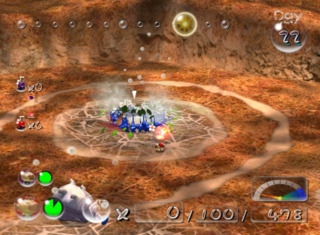
If the dungeons leave you feeling in over your head, you will find some comfort in another new mechanic: spiderwort berries. Bring ten spiderwort berries back to the Rocket, and you'll get one spray. Red berries crush into the Ultra-Spicy Spray, which increases your pikmins' attack for a limited time. Purple berries liquify into the Ultra-Bitter Spray, which petrifies enemies temporarily. Again, there's some nice variation here as it's not that both sprays buff your pikmin or debuff your foes; one does the first thing, and one does the second thing.
A lot of the player powers we could dream up would ablate the challenge if they stuck around. However, designers can give us immense abilities while preserving the difficulty balance. They can do this by letting us implement those powers only in the short term. If we have to manually trigger a perk instead of the systems passively applying it for us, it also tests our judgement and gives us the gratification of knowing we matched the right tool to the right job. This is how Pikmin's sprays work. But most fruits of the environments are one-per-customer for a reason. Treasures never respawn, and dead animals and flowers only repopulate overnight. But if you pick all the berries on a plant, a fresh bushel grows in their place immediately. So, the game encourages us to grind the berries. Instead of running around the map, crossing off a lot of different chores, we're just sending the little guys back to the spiderworts every time.
Controls
We do get another leg up, one that involves no monotonous farming. With the D-Pad, we can change which colour pikmin we'll throw when we press A. It's a feature that was sorely missing from the original entry. The directional pad went unused in Pikmin 1, so there's no reason this control couldn't have existed all along. But it's here now and is a vital inclusion now that we have five shades of buddy to organise.
Endings
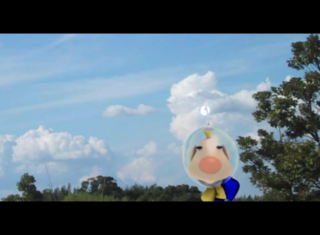
All of this, the caves, the new Pikmin, the treasure, has to swell towards some kind of ending, or endings. If I tell you that Pikmin 2 has three endings, you might think, "Of course, like Pikmin 1", but in that game, you experienced one of three based on your performance on the planet. This time around, the endings are lined up in a row. When we pay off the 10,000 poko debt, we get a cutscene in which Olimar blasts off on a well-deserved return to his pining family. As the Rocket readies to go to warp, he looks back through the empty passenger seat of his craft to see images of the Pikmin overlayed onto Earth. For him, they are the planet. Then, in a genuinely hilarious physical gag, he double-takes at that empty passenger seat. We forgot Louie! Cut to credits.
After spending this long on a microscopic Earth, we've habituated to it, but the vignettes in the outro make it weird again. They situate Louie in live-action footage of real plants. Once all the names have rolled by, he looks longingly at the sky, probably wondering why his superior left him, and then stares at us, the viewer. I don't like that. To exfiltrate Louie, Olimar has to make his third trip to the planet without a break, this time with The President standing in for his first mate. Even as the game appears to be drawing to a close, there's so much left to do as we unlock a new area with three caves. With ice, grass, water, and autumnal biomes now on our radar, Pikmin 2 presents the seasons as places rather than times. It's under the amber-leaved canopies of the Wistful Wild that we descend to meet the Titan Dweevil and its small arsenal. That's how we get Louie back. He's worth 10 pokos if you were wondering.
In one more creepy twist, the game all but confirms that it was Louie (now insisting on being called the "King of Bugs") that took control of the Dweevil's brain and turned it against Olimar. Perhaps like Olimar in the first game, Louie also adapted to the planet, but through technological superiority rather than physiology. And maybe he wasn't too eager to go home after all. This is effectively a second conclusion to the game, but a third is still available.

Disconnecting Louie from the arachnid doesn't mean we've collected all the treasure. The most irritating task on the road to 100% is acquiring a dumbbell that the characters call the "Doomsday Apparatus", although I prefer the name from the German version of the game: the "Hellmachine". Hellmachine is right because you need 100 purple pikmin to carry it back to base. As you can only grow purples in dungeons, and they can be killed off by attackers in those same instances, you might have to flush yourself through the same caves ad nasuseum to plant 100 bodybuilders.
Ending
The million poko question is whether Pikmin 2 is better or worse than its sensei, and the answer is you can't think about them like that. Pikmin 2 is so self-possessed that some mechanics don't have an equivalent in Pikmin 1 we could compare them against. The sequel is a far more generous helping of everything fans loved about the original: settings, treasures, and enemies. As fondly as Pikmin 1 is remembered, if you tried to release a full-price eight-hour game today, there'd be riots in the streets.
Pikmin 2 is also a much more frustrating foray into Earth's undergrowth, one that, at times, is oppositional to the player's goal of having fun. But it's not that Pikmin 2 makes the predictable game sequel mistake of broadening scale while relaxing quality. This isn't a AAA blockbuster with a bunch of half-baked side-quests thrown in. Despite the unpalatable booby traps and inability to replace lost troops in its dungeons, Pikmin 2 is a game that, rather than just increasing the volume of "content", is thinking about what systems it didn't let you tweak before and how it might give you the keys to manipulate them this time. It's a game that wants to experiment with structure and that gives you a new perspective on your home. And it's a game that, for all its annoying howlers, is hard not to appreciate as an imaginative exercise in design. Thanks for reading.